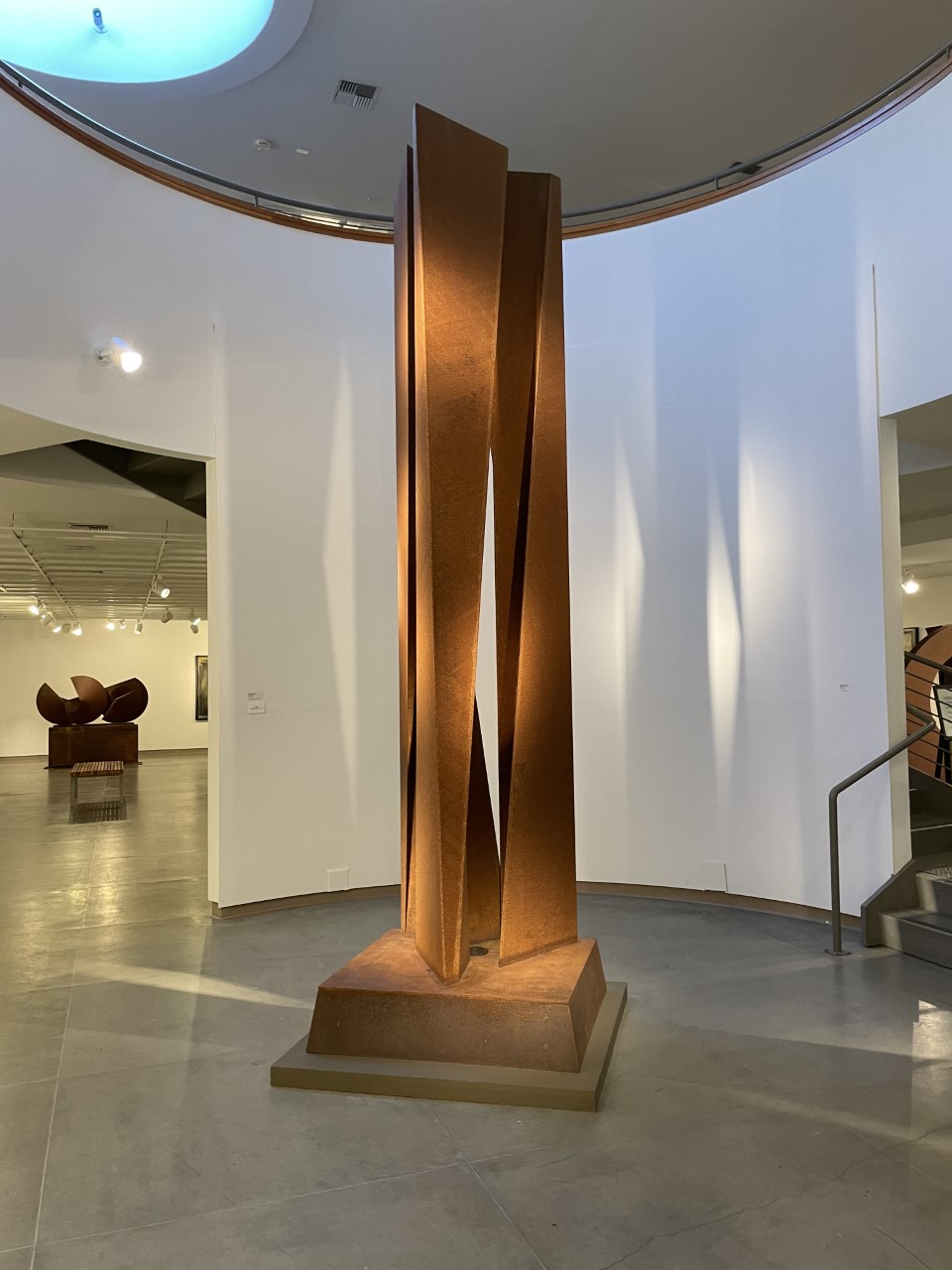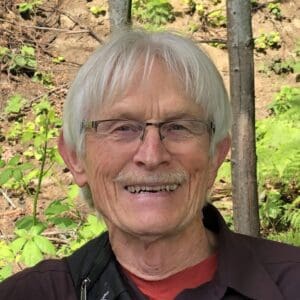Soaring over the entrance hall of the Museum of Northwest Art (MoNA) is a 12-foot-high sculpture, “Segmented Prism #2,” by Whidbey Island artist and educator Richard Nash. For the “Consonance” exhibit, eight strong men carried it in, raised it up and anchored it to its base.
It’s the tallest of the monumental sculptures lining the La Conner-based gallery, a few in aluminum, most of them fabricated in Corten steel — a commercial material developed to form a coating that protects structural steel from being destroyed by rain. Artists have found beauty in this glowing orange material, which works in partnership with the Pacific Northwest climate.
“Conical Consonance 7” and “Conical Consonance 8,” massive horizontal sculptures in glowing Corten, introduce us to Nash’s fascination with segments of cones. Here and in the neighboring gallery, he slices them or punches the metal into pointed wheels — for example, “Reciprocity 3” — to give the viewer many options to ponder.
Nash’s sculptures are too massive to be brought into being by one person working alone. They begin when he draws the architectural designs and working specifications. One of his former students, Greg Hancock, translates these to AutoCAD. For fabrication, Nash turns to a talented group of metal workers at Superior Systems, Inc., in Skagit County. When an original design looks impossible with the available techniques, the talented crew — including “ZZ” Welles, Obadiah Durham, “Big Mike” Edson and owner Mark Wolfe — help Nash work out an alternative. Ultimately, he is the creator, “primary problem-solver, grinder and grunt while also being the ‘boss’ and project manager.”
Paintings by Nash line the halls. Not bold and commanding like his metal sculptures, the paintings are subtle and mysterious, although equally abstract. The large, brilliant works he painted as a student are not here. The earliest which have been chosen, from 1994, “Ledges” and “Bluescape” (each acrylic on canvas), reflect the beauty of Skagit seas and lakes.

In the new century, Nash found his lasting, personal, abstract style. As Curator Stefano Catalani writes, he “abandoned bright color in favor of a neutral, Northwest School palette to place composition and the play of light and shadow at the center of his painting.” He directs our attention to Nash’s ability to “weave” the visual elements to give the viewer the impression of being on both sides of “door frames, thresholds and ledges.”
Nash begins a work by drawing in pencil a “frame” on acid-free museum board. Within the “frame” he applies a coat of acrylic paint with a short-nap roller. When dry, he sands it lightly to “knock down the texture.” This leaves fine pits in the surface which will hold contrasting colors later on. Now, using thinned acrylic wash he creates “interest lines” which may be partially geometric, thought-out ahead of time, or spontaneous. He continues to work in thin coats of color mixed with polymer gloss medium, which creates translucency, “teasing up” very thin lines with brushes and wiping away layers with a paper towel.
Several of the paintings at MoNA dating from 2007 and 2008 — for example, “Sanctuary,” “Emergence” and “Seeking Light” — suggest something locked and hidden, a subtly different feeling from those which follow. The large, paired “Indigenous Light” and “Bauhaus,” both from 2010, banish that ambiguity.
“Transition” (2016) is reminiscent of “Sanctuary,” but far more mysterious, having greater depth, an impression of mystery and solitude. “Out in the Ether” (2020) reminds us of Nash’s sculptural concerns, with circles and angles. “Spring Forms” (2020) shares the palette and the sculptural forms but has more dynamism, with a downward, driving force. Also from the same year is “Free Fall,” a delightfully whimsical composition.
And what does “Consonance” mean as the title of the exhibition? The word usually describes a poetic text in which consonants repeat in a rhythm. And that rhythm is what Nash’s art is all about — a subtle and deliberate juxtaposition of similar elements, without reference to recognizable objects, in which composition itself is the subject matter.
Don’t miss the exhibit of new acquisitions to the MoNA collection, which is also on the main floor. It represents the museum’s efforts to collect work by women, Indigenous artists and other minorities. I found “Passages” (1975) by Margaret Tomkins (1916–2002) offered a striking comparison to the work of Nash in the main gallery.
See Richard Nash’s “Consonance” exhibit from 10 a.m. to 5 p.m. daily through Feb. 5 in La Conner at the Museum of Northwest Art, 121 S. First St. Admission to the gallery is free. Info: monamuseum.org.





